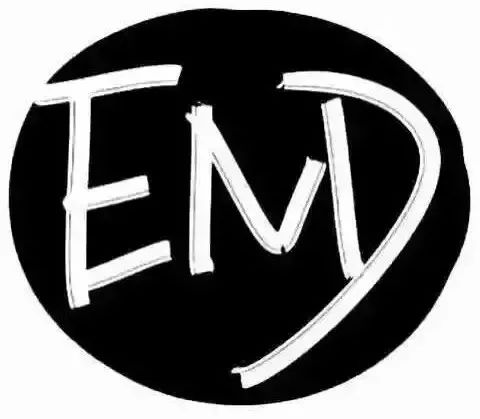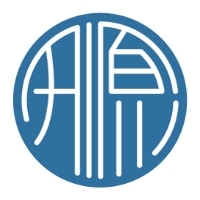Click above“ Kaiyuan Cooperative ”Follow us

|Reprinted from: Weiyue Renhua
Introduction of Kaiyuan News Agency
There are various codes in GitHub's vast code sea. However, these codes are not "what you see is what you get". Seeing the code does not mean that you can copy and paste it freely. We also need to know whether it is authorized by the public with an open source license, or it may cause disputes or even infringement.
MIT is one of the most common open source licenses on GitHub. As a contract template, it guarantees the rights and obligations of code intellectual property. However, do you really understand its connotation? This article introduces the content of MIT in the vernacular as much as possible. No matter you want to publish code on GitHub or use MIT licensed projects, you need to have a correct understanding, so that you can travel in the open source world as you wish!
—————— Lin Lvqiang Richard, director of Kaiyuan and member of the Legal Advisory Committee
I have seen Li Xiaolai's story happened to him before. He said that when he lived in Shuangyushu in 2001, he often went to the underground supermarket of Shuang'an shopping mall to buy something. Once he bought something and felt bad, he wanted to return it. The supermarket attendant said that according to the regulations, such goods could not be returned once they were sold. Li Xiaolai was furious and said that if you took out the written regulations, I would not return some of them, If not, I must return. Finally, I called the manager of the supermarket. The manager saw that the newcomer was not good, but Li Xiaolai could not argue with me, so he returned.
What does this story mean? In fact, we all know that many management regulations of Chinese supermarkets more than 20 years ago were verbal. How could they be written in black and white.
From the point of view of the supermarket waiter, Li Xiaolai's behavior is to make trouble, to be disorderly; Li Xiaolai must feel that he is defending his legitimate consumer rights; The supermarket management should be the most shocked. If it were me, I would immediately ask to draft a regulation on return and replacement. I really don't want to meet the next one.
This is the spirit of the contract. I agree with everything that has been said and written down.
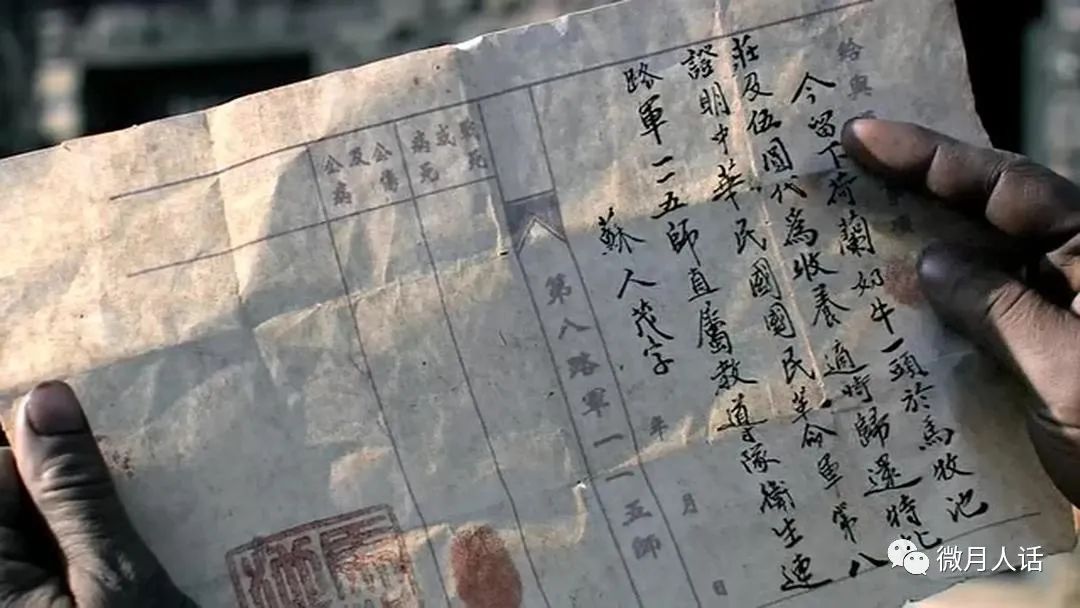
Now let's talk about the MIT protocol.
The MIT Agreement is the famous open source software license agreement The MIT License, also known as the MIT license.
Someone made a special analysis two years ago 1,
MIT is the most used license on Github,
The second to fifth places are Apache 2.0, GPL 2.0, GPL 3.0 and bsd-3-clause.
Note: In this article, "MIT Agreement" and "MIT License" are equivalent.
What is an open source license?
The open source license is like this. I put the source code on the Internet. If it is good, many people ask me if I can use your code? Can I put your code in my product? I used your code. Why are there so many bugs? I want to use your code as a teaching case. Is it OK? What's more, I used your code. I feel good. I also changed a lot of places. I also put it on the Internet, and I also changed the name. Do you have any suggestions? I'm going to change my name if you have any questions, because now in this software, I write more code than you!
(This is more copyright conscious, and I'm afraid you will use it to get involved in a lawsuit in the future.)
I'm too lazy to answer so many questions. I write these questions into a paragraph and put them in my code, which means:
I allow you XXX, I allow you XXXX, you can XXXX, but you must XXXX, if you XXXX, you must XXXX, by the way, I am not responsible for XXXX.
If you agree, use it. If you disagree, don't use it. If you use it, but violate the requirements of the license, I may sue you!
You can write a license yourself, but if you are lazy (most people are lazy), you can use the license written by others.
There are many well written open source licenses, such as GPL, BSD, MIT, Apache, etc. MIT is just one of them.
You can choose one that suits your taste. These license templates are free. After all, no one expects this to sell for money.
As for their differences, you can take a look at the picture below to accept popular science.
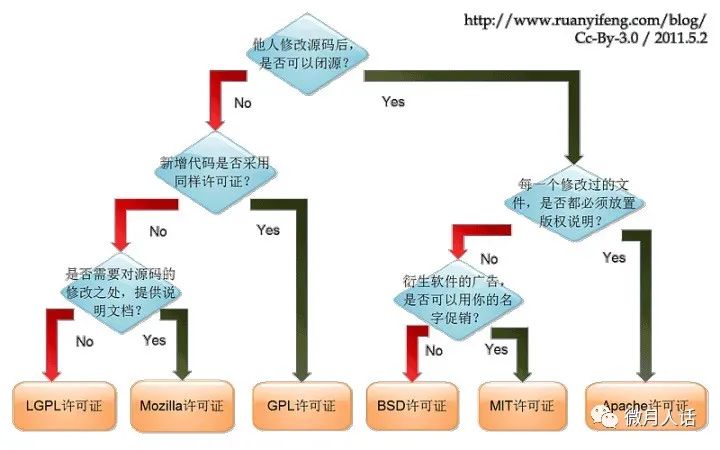
Some time ago, there was some news about an open source project called "New Bee Mall" ("New Bee" for short). It used the MIT license, and its author was told that, hey, your open source software was sold online, you don't care?
When the author saw it, it was true that some up owners sold it on station b, and some people sold it on idle fish. Although it was not expensive, some sold 300, and some sold dozens of them. But at a glance, it was clear that they were selling their own "new bees"!
Then there was a bit of excitement. Some people said it was an infringement. They should support the author and accuse someone of being so shameless; Some people say that this is not infringement. MIT is a very loose agreement. Basically, you can do anything as long as you keep the copyright of the author.
The author didn't want to deal with it. He just thought, "I took time off work to write projects for half a year intermittently. It's not hard work. It's my little work. Open source is just for you to play like this. I admire you."
Maybe the author is still young and doesn't understand the dangers of the world!
In fact, this should be expected.
There should be no psychological turmoil.
What's more, the MIT license allows others to sell your source code!
In terms of contract spirit, let others do what they say they are allowed to do.
There is a problem that novices can't understand. Why do they have a license to allow others to sell their own open source software?
This is about the spirit of open source. Readers without any idea can take a look at this article first: Seven ideas of open source
Those who played open source in the early days, most of them did not open their own code to sell software. Most of them had an ideal complex of openness, sharing, freedom, breaking monopoly, etc,
The only thing that can be illustrated is probably a "name",
So almost all licenses require the author's name to be retained.
In order to better spread their own code, open source authors usually allow others to sell their own source code. At the initial stage, we will consider such a situation: if someone burns Linux source code into a CD for distribution, should we charge a cost fee, or a service fee?
If someone makes a huge profit, wouldn't it be a big loss? Usually not. Because since you can download the source code for free on the Internet, people who understand it will not spend a lot of money to buy it.
For example, the open source cloud native SQL database CockroachDB announced to modify the open source protocol from the original Apache-2.0 protocol to BSL (Business Source License), which requires that the only thing users cannot do is to provide database as a service (DBaaS) in a commercial form with CockroachDB without authorization.
BSL was designed by Michael "Monty" Widenius, the developer of MySQL, in 2013. It has three main characteristics: first, there is no restriction on non-commercial use, and there is restriction on commercial use; Second, the user's own requirements can be attached to the license; Third, there is a change date. Since then, the source code will be converted from BSL to other licenses designated by the author, such as GPL and other open source licenses.
In my opinion, it's normal to sell "Xinfeng" for tens of dollars on idle fish and also take advantage of after-sales service.
What exactly did MIT say (learn English!)
First look at the original text:
Copyright ( C )
Permission is hereby granted, free of charge, to any person obtaining a copy of this software and associated documentation files ( the "Software" ) , to deal in the Software without restriction, including without limitation the rights to use, copy, modify, merge, publish, distribute, sublicense, and/or sell copies of the Software, and to permit persons to whom the Software is furnished to do so, subject to the following conditions:
The above copyright notice and this permission notice shall be included in all copies or substantial portions of the Software.
THE SOFTWARE IS PROVIDED "AS IS", WITHOUT WARRANTY OF ANY KIND, EXPRESS OR IMPLIED, INCLUDING BUT NOT LIMITED TO THE WARRANTIES OF MERCHANTABILITY, FITNESS FOR A PARTICULAR PURPOSE AND NONINFRINGEMENT. IN NO EVENT SHALL THE AUTHORS OR COPYRIGHT HOLDERS BE LIABLE FOR ANY CLAIM, DAMAGES OR OTHER LIABILITY, WHETHER IN AN ACTION OF CONTRACT, TORT OR OTHERWISE, ARISING FROM, OUT OF OR IN CONNECTION WITH THE SOFTWARE OR THE USE OR OTHER DEALINGS IN THE SOFTWARE.
If you are not good at English, you will faint!
Even if English is OK, you should look at it for a while if you want to understand it!
When analyzing the sentence structure, it is actually the following. Note that what is put in the brackets is not the main component of the sentence:
Permission is
( hereby )
granted
( , free of charge, )
to any person
( obtaining a copy of ( this software and associated documentation files ( the "Software” ) ) ) ,
to deal in the Software without restriction,
( including without limitation the rights (
to use, copy, modify, merge, publish, distribute, sublicense,
( and/or )
sell copies of the Software, and to permit persons
( to whom the Software is furnished )
to do so
) ) ,
subject to the following conditions:
It roughly means:
The license is granted to any
(The person who obtained the copy of this software and related documents)
The software can be processed free of charge and without restrictions
(Including random use, copy, merge, release, distribution, sublicense, sell copies, and sublicense others (those who are equipped with the software) to do the above things).
Note that "to permit" here and "to permit persons" are parallel to "to use" and "to copy". "to do so" in the back refers to a series of rights in the front, and "to when the Software is enriched" refers to the person who is decorated and the person who is assembled and distributed the software.
What's more interesting is that in this long range of licensed options, an and/or appears later.
And/or is generally used to connect two options, such as A and/or B, which means A or B or both. In this passage, and/or only connects the last two options, but it seems to be intended to connect all. For example, A, B, C, D and/or E is intended to express: A and/or B and/or C and/or D and/or E, which means that A, B, C, D and E can be selected in any combination. This writing seems rigorous, but in fact it is redundant. Because without it, the understanding of the meaning of the text will not be affected at all, and with it, doubts will increase. (In literature or legal terms, there are more criticisms of the use of and/or.)
The above copyright notice and this permission notice shall be included
( in all
( copies or substantial portions )
of the Software ) .
The above copyright notice and license notice must be included (in all complete copies or substantial components of the software). The so-called substantive component can be understood in this way. For example, if you modify the software but only change 5%, then the copyright statement and license statement must contain it. If you change 95%, then it is not necessary. The specific need depends on whether it is actually someone else's.
THE SOFTWARE IS PROVIDED "AS IS”,
( WITHOUT WARRANTY OF ANY KIND ( , EXPRESS OR IMPLIED, ) ( INCLUDING BUT NOT LIMITED TO THE WARRANTIES OF MERCHANTABILITY, FITNESS FOR A PARTICULAR PURPOSE AND NONINFRINGEMENT. ) )
IN NO EVENT SHALL THE AUTHORS OR COPYRIGHT HOLDERS BE LIABLE
( FOR ANY CLAIM, DAMAGES OR OTHER LIABILITY, (
WHETHER
( IN AN ACTION OF CONTRACT, TORT )
OR OTHERWISE
( , ARISING FROM, OUT OF OR IN CONNECTION WITH ( THE SOFTWARE OR ( ( THE USE OR OTHER DEALINGS ) IN THE SOFTWARE. ) ) ) ) )
This passage mainly means that the software is "AS IS". "AS IS" means "just like this". After being sold (or provided free of charge), we will not take any responsibility. "Don't look for me again, just like this". If you have any problem, just accept it or try to deal with it yourself. Anyway, I don't care about it anymore. That's what I mean. Sometimes when I sell second-hand goods on "idle fish", I really want to add a logo "AS IS", but considering that many people do not know the word, it is OK.
The above all capital English paragraph is very long, but it's OK, not too difficult, basically:
This software is from AS IS
(No warranty is provided (whether explicit or implicit, including but not limited to the warranty of marketability, applicability and non infringement)),
In any case,
(for any rights and interests recourse, loss compensation or any accountability),
Neither the author nor the copyright owner is responsible.
(No matter whether these claims arise from contract, infringement, or directly or indirectly from the software and the circumstances related to the use or operation of the software)
MERCHANTABILITY means that once a product is sold (although it may be free), it can be returned or replaced if there is a problem. Generally speaking, marketability is the default guarantee (even if not explicitly stated), and the law will support consumers' right to return or replace unqualified products. But for products like AS IS, that means you can't find me if you don't feel comfortable. Don't ask me if you think it is impossible to use (FITNESS FOR A PARTICULAR PURPOSE), and I don't guarantee whether my software is infringing.
The MIT agreement has spent almost half of its space on this, which is enough to see its importance. This is due to the strong commodity economy awareness and legal awareness of Westerners.
This is an attitude of getting rid of relationships, that is, don't ask me for anything, let alone go to the court to sue me. I'm not trying to make trouble for myself by contributing source code to you. I don't earn your money.
Just imagine, if you use "this software" in the software of a medical device, and the result is a medical accident due to a bug, and if you trace it down, you will have trouble with me, how can I stand it!
To pick out all the trunks in this license is to:
Permission is granted to any person to deal in the Software without restriction,subject to the following conditions:
The above copyright notice and this permission notice shall be included.
THE SOFTWARE IS PROVIDED "AS IS", IN NO EVENT SHALL THE AUTHORS OR COPYRIGHT HOLDERS BE LIABLE.
Translated from the full text, about this,
The copyright of the following translation belongs to me:
MIT Open Source License Agreement (Chinese translation: Wei sir, following the CC-BY agreement)
Copyright (C)<fill in the year><fill in the name of the copyright owner>
It is hereby authorized to any person who has obtained the copy of the software and related documents (hereinafter referred to as "the software"): the licensee has the right to use, copy, modify, merge, publish, distribute, sublicense, sell the copy of the software, and has the right to grant the same rights to the supplier, provided that the following conditions are met:
All copies or substantive uses of this software must contain the above copyright notice and this authorization notice.
This software is provided "as is" without any express or implied warranty, including any warranty of merchantability, applicability, non infringement and other guarantees. In any case, the author or copyright holder will not be responsible for any rights recourse, damages and other liabilities. Whether these claims arise from contract, infringement, or directly or indirectly from the software and the circumstances related to the use or operation of the software.
Translated into a simplified version of Chinese, it is about the following:
The copyright belongs to me XXX, which originated in XXXX this year!
I authorize anyone to do anything, including selling copies!
However, you must:
Keep my copyright and license!
This software is just like this! Don't use it. Don't call me when something happens
How can I use someone else's code to be compliant?
Using a source code that uses the MIT protocol, you only need to retain the copyright and license information of others.
That is to say, the LICENSE file should be included. This file has a complete MIT license, and the copyright information of the author will also be included.
You should also keep the copyright and license headers in other people's source code.
Since the MIT protocol does not require users to disclose the source code, if you release only executable software (without source code), you should explain it on an interface of the software.
For example, Google Chrome uses a lot of open source software, which is clearly indicated in its interface.
In the "About" of Chrome browser, there is a saying: "Google Chrome cannot be born without the Chromium open source project and other open source software."
Click "Open Source Software", and a page will open, listing a long list of open source software, its LICENSE and home page (or code hosting place).
Here are some screenshots:
I randomly find a software that uses the MIT protocol: brotli
After entering the code warehouse, you can see that the source terminal department wrote
/* Copyright 2013 Google Inc. All Rights Reserved.
Distributed under MIT license.
See file LICENSE for detail or copy at https://opensource.org/licenses/MIT
*/
The screenshot is as follows:

Note this usage. The first line indicates the copyright, and the following is a reference to the MIT license. This is more concise.
After all, the only thing that needs to be filled in the MIT license is copyright. So just put the information in the first sentence here, and the MIT license does not need to be moved.
Note that copyright refers to the copyright of the software, and license refers to how the copyright owner allows others to use the software.
The phrase "All Rights Reserved" behind the copyright can be written or not, which is just a form. If you really go to the court, all rights are subject to copyright related laws.
Explain the concept of year in copyright:
When the software is released, the copyright will be declared, including the year, such as Copyright 2012, Copyright 2008-2012, etc. If only one year is included, this is the year of first release. If a time period is included, the first year is the year of the first release, and the second year is the year of the current version.
For example, Microsoft's Windows XP copyright notice: Copyright © 1985-2001 Microsoft Corp。 Description The first version of Windows was released in 1985, and the Windows XP version was released in 2001.
I am the author, how do I use the MIT protocol
If my open source software wants to use the MIT protocol, what should I do?
This should usually be done:
-
In the first level directory, a LICENSE (or COPYING) file is given, which contains the full text of the license.
-
In the header of all source codes, indicate the copyright and license.
Note: Some projects use multiple licenses, and a license directory will be created to store these licenses. (such as cockroachdb)
In the copyright line, you can also write your software's home page or code storage location. Generally speaking, users should not delete this line.
For example, the "Mulan License" guides people to use it:
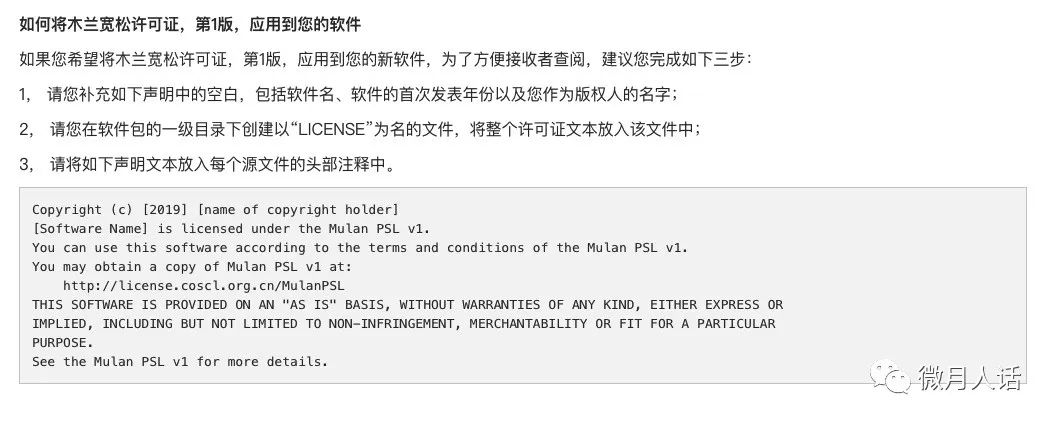
So, how does "New Bee" do it?
I took a special look at the github warehouse of "New Bee". Yes, the author placed the LICENSE file in the first level directory.
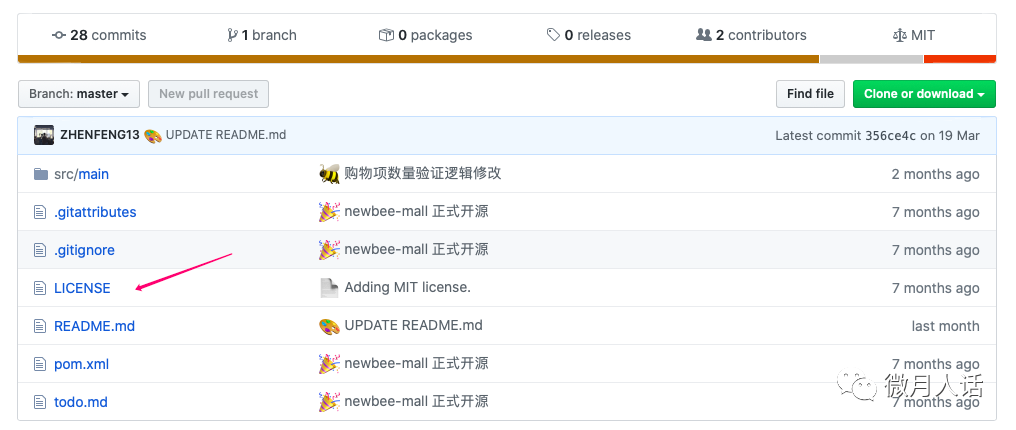
Open the LICENSE file, you can see:

The year was written as 2019-2029, and the copyright owner wrote as newbee mall.
This needs to be improved. The year should not be written to 2029, but the year when the current version is released.
The copyright owner should write the author "13" (or "13") instead of the name of the software.
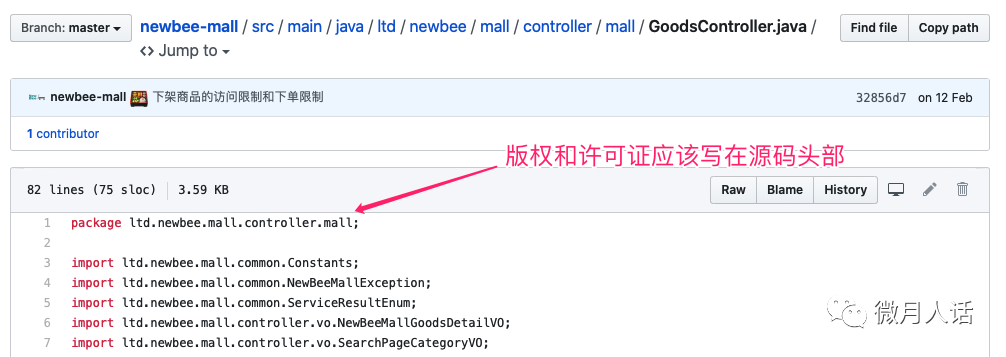
After turning it over, I didn't find any copyright and license information in the head of any source code, and this practice is not standardized.
It can be seen that the author has never studied the open source license.
Some questions and answers
Can I change my license?
Certainly. (MIT allows you to do anything)
Therefore, MIT protocol has strong compatibility with other protocols (actually one-way compatibility). For example, it is completely possible to change a MIT protocol software to GPL, but a GPL can not be changed back to MIT.
Can I write a license myself?
Certainly.
Can I not write any permission?
Of course, if you don't write permission, you will "reserve all rights". You can ask them to call you, write an email to ask you, send a WeChat message to ask you, and then tell them what they can do.
The meaning of keeping the license basically means that they can do nothing except look at your source code (because you have opened it up) and the rights mentioned in the copyright law.
If I reserve all rights, does he have the right to run?
If it is for learning, research or appreciation, it can run.
He can also comment on your software.
Because China's copyright law gives him such rights:
Article 22 of the current Copyright Law of the People's Republic of China (revised in 2010) stipulates that:
Under the following circumstances, a work may be used without permission from, and without payment of remuneration to, the copyright owner, provided that the name of the author and the title of the work shall be specified, and other rights enjoyed by the copyright owner in accordance with this Law shall not be infringed:
(1) Using published works of others for personal study, research or appreciation;
(2) In order to introduce, comment on a certain work or explain a certain problem, the published work of others shall be appropriately quoted in the work;
……
What if someone doesn't follow my permission?
You can sue him.
However, whether we can win the lawsuit is another topic!
*The pictures in this article are from the network. If there is infringement, please contact to delete!
Introduction to Kaiyuan News Agency
The Open Source Society is a manufacturer neutral, volunteer and non-profit open source alliance organized by enterprises, communities and individuals at home and abroad who support open source in accordance with the principle of "contribution, consensus and co governance", aiming to jointly create a healthy and sustainable open source ecosystem and promote the Chinese open source community to become an active participant and contributor of global open source software. We focus on open source governance, international integration, community development and open source projects.
Related reading | Related Reading

go online! Chatopera Launches Open Source Dialogue Corpus for Psychological Counseling
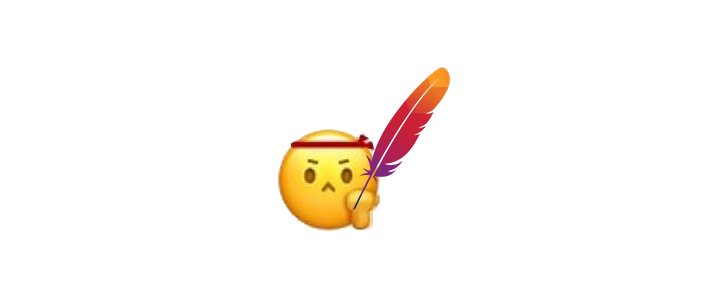
How did the ASF Board of Directors develop?
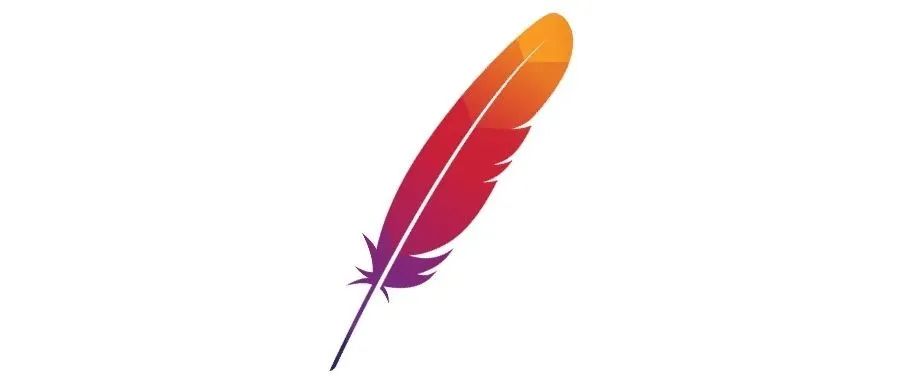

How to use open source for public welfare?












